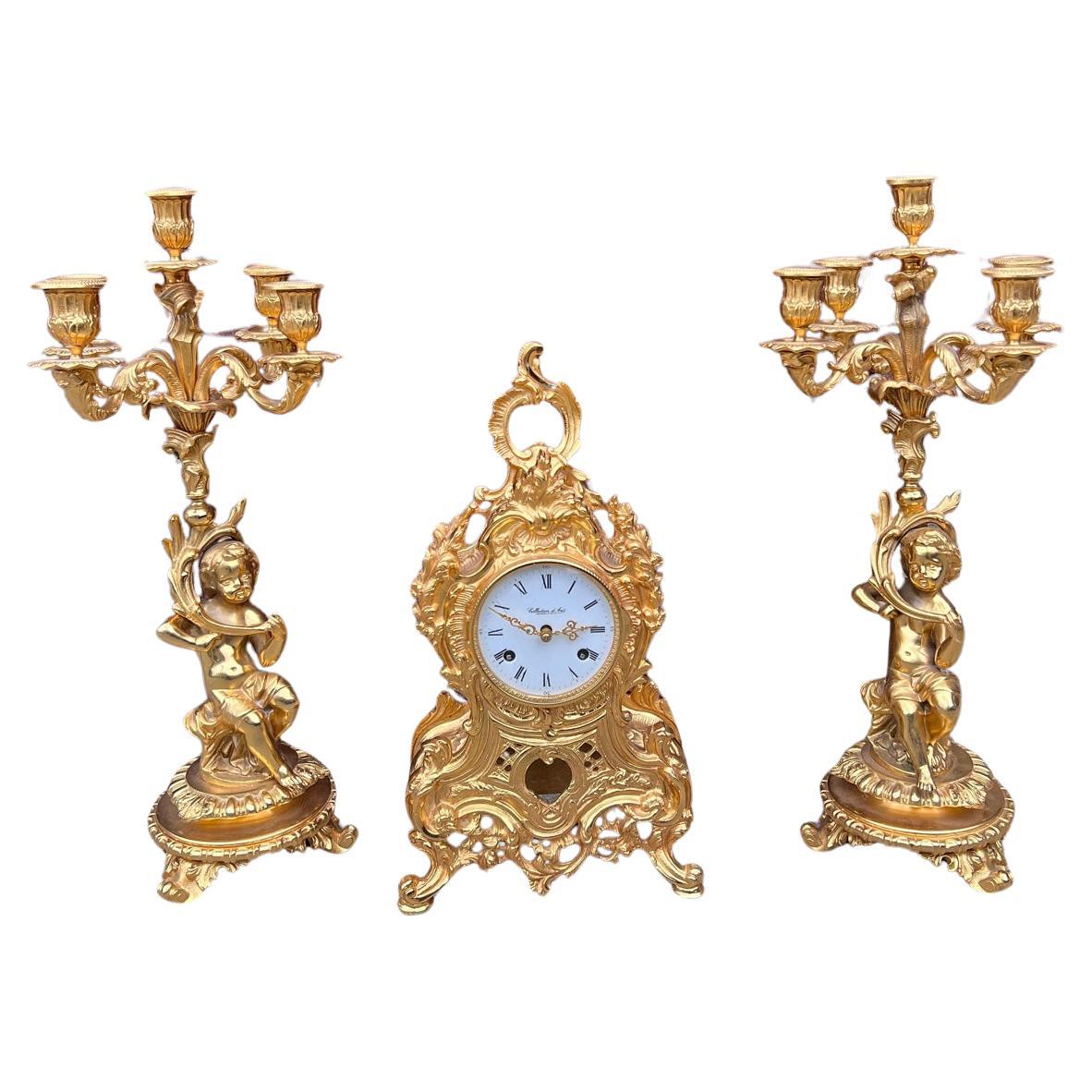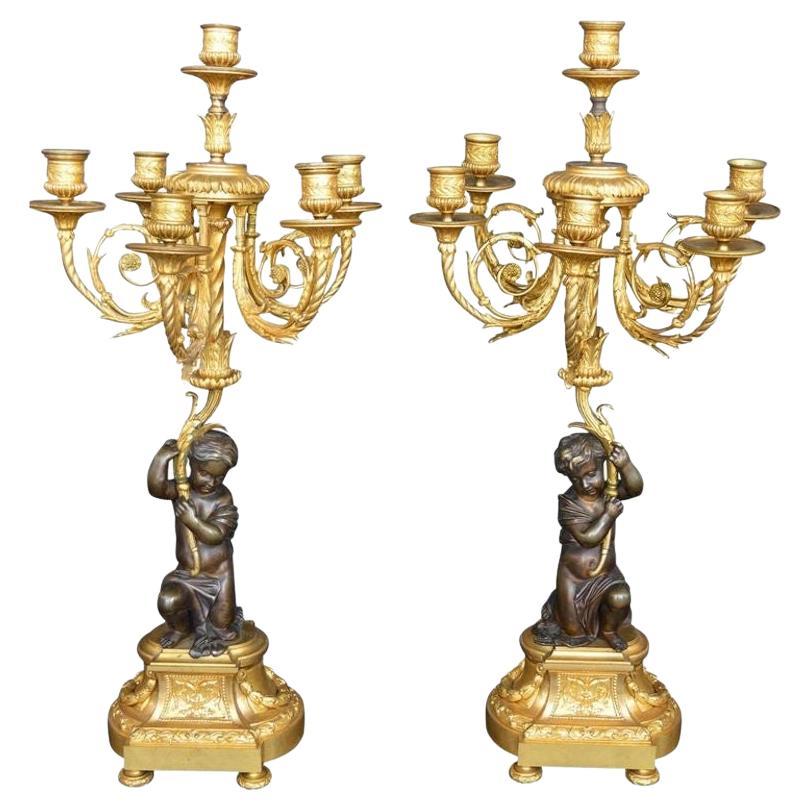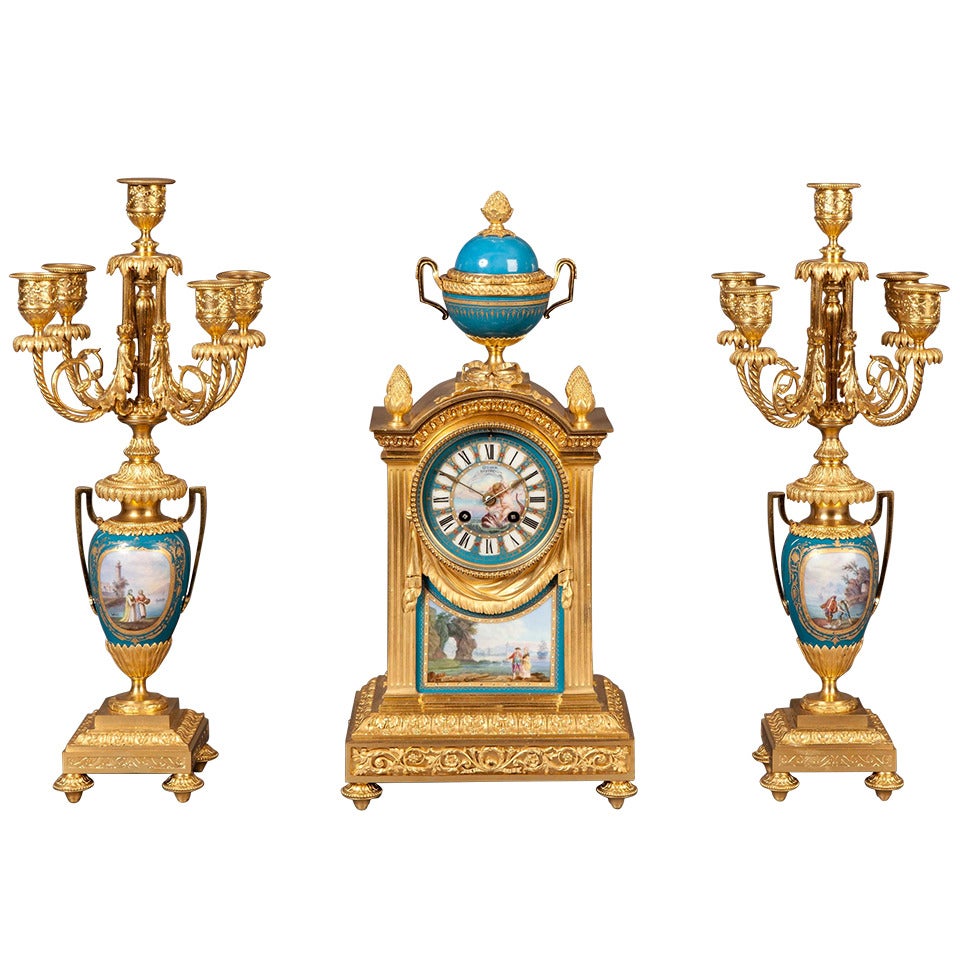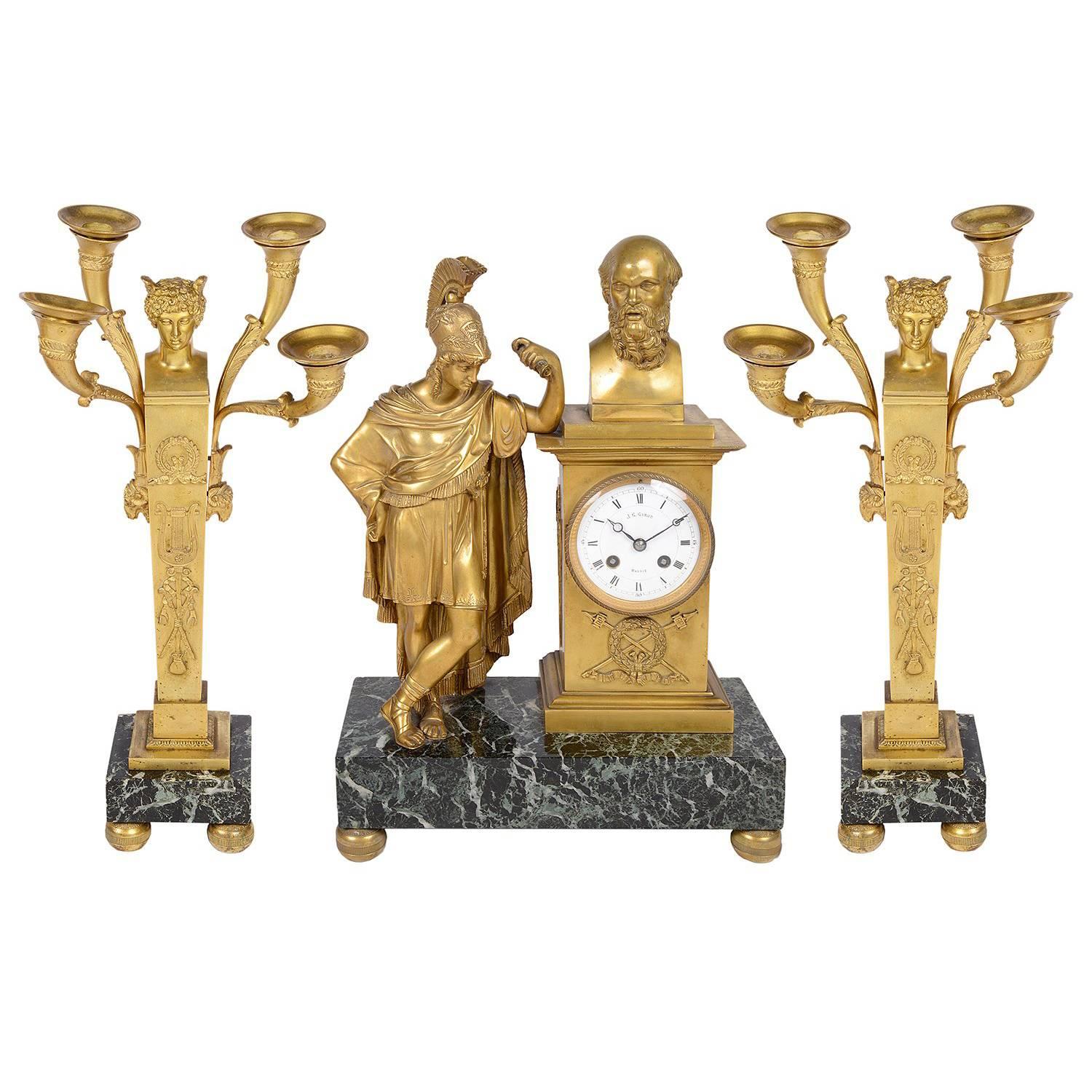Items Similar to Equestrian statue of William I and two candelabras with halberdiers
Want more images or videos?
Request additional images or videos from the seller
1 of 19
Equestrian statue of William I and two candelabras with halberdiers
About the Item
Mantel garniture with clock and pair of candelabras in brown patinated bronze on Statuary marble and gilt bronze pedestals.
Equestrian statue signed and dated : « E de Nieuwerkerke 1843 » on the base and bronze caster's mark « Susse Edt »
Dimensions of the clock : H. 84 cm (33”1/16) x W. 46,5 cm (18”5/16) x D. 24,5 cm (9”11/16)
Dimensions of the candelabras : H. 90,5 cm (35”5/8) x W. 25 cm (9”7/8) x D. 25 cm (9”7/8)
At the “Salon des Artistes Français” in 1843, the young Count Alfred Emile de Nieuwerkerke (1811-1892), then aged 32, presented a plaster equestrian statue entitled William I, known as the Taciturn, Prince of Orange. A great nineteenth-century sculptor, Émile de Nieuwerkerke is best known for having been Head Director of the Museums since 1849, and probably the most influential man on cultural policy in France until the end of the Second Empire. Nieuwerkerke's fervor for art began when he became passionate for sculpture, at the age of 23, and took classes with the great James Pradier and Baron Carlo Marochetti. His connections allow him to realize official commissions, including the busts of the Empress Eugenie and Louis Napoleon Bonaparte. The Count de Nieuwerkerke made a name for himself at the 1838 Salon with the exhibition of the group The Death of the Duke of Clarence that really launched his career.
Having been a pupil of Carlo Marochetti, a sculptor of Italian origin, the young Nieuwerkerke can only be strongly impressed by the equestrian statue of the Monument to Emmanuel Philibert, Duke of Savoy created by the master between 1833 and 1838 and adorning the Piazza San Carlo of Turin in Italy. There is no doubt that this monumental statue is in Nieuwerkerke's mind when he realizes for the Salon of 1843 his plaster of William the Taciturn. Presented under the number 1477, the booklet of the Salon describes the hero's life: “William of Nassau, Prince of Orange, was born in 1533 at the Castle of Dillembourg, from Julienne Stolberg and Count Guillaume de Nassau, said the Old. He fought long against the injustice of Philip II and the tyrannical yoke of Spain. He freed his country and conquered the liberty of Holland, which he confirmed by the union of Utrecht, signed in 1579.”
The proximity between the two sculptors is all the more illustrated by this mantel garniture where the bronze caster Susse associates the equestrian statue of Nieuwerkerke with the halberdiers of Carlo Marochetti.
From 1843, Nieuwerkerke has an extremely ambitious project for his equestrian statue. In line with Carlo Marochetti's Monument to Emmanuel Philibert, Nieuwerkerke expresses the wish to see William the Taciturn erected into a monumental statue. William II, king of Holland since 1841, had also intended to erect a monument to the glory of his ancestor. Baron Fagel, ambassador of the Netherlands in Paris and linked to the family of Nieuwerkerke, then proposes the project of the young sculptor who goes to the court of Holland to present in person a model of his project. William II commissioned the statue at his expense and it was inaugurated on November 17th, 1845 in front of the Noordeinde Royal Palace in The Hague.
The posterity of the equestrian statue of Nieuwerkerke is twofold, since as early as 1844 and even before the monumental sculpture was made, it appears in the catalog of the oldest art foundry in Paris, the Maison Susse. Nieuwerkerke was the first sculptor to sign his bronzes, which is a real innovation. Maison Susse offered the art bronzes in its catalog on single pedestals and pendulum bases, as well as matching candelabra sold separately. Here we have a clock and two original candelabras from the Maison Susse, whose models were shown in the catalog.
The success of Nieuwerkerke's equestrian character goes on, since it is still proposed by the Maison Susse in its catalogs from 1860 and 1875.
In 1856, Pierre Malitourne devotes an important article to the Count de Nieuwerkerke in the magazine L'Artiste (August 3, 1856, 3rd delivery, pp. 57-60) and writes at length about the statue of William the Taciturn:
“It was time for the young sculptor to give a stronger evidence of his talent. One of these artist's dreams had just taken shape in his imagination and became clear in a creation that remains until now the capital work of Mr de Nieuwerkerke: we clearly designate the equestrian statue of William the Taciturn. According to the usual processes of art, the design of William the Taciturn was first treated in small dimensions. In a word, the sculptor made his sketch. But, probably wishing a clearer and more decided impression of the choice and the effect of the details, he pushed the execution of the model until the rendering, and the equestrian statue ended with a quarter of nature and was exposed in his workshop. It was the following year that M. de Nieuwerkerke undertook the execution of his statue in monumental proportions. Since the rue Verte studio did not have the space for this work, the artist obtained from the government a larger workshop on the île des Cygnes. There, was promptly modeled, with the sustained ardor of the artist who loved his work, the large equestrian statue which today decorates a place in The Hague. We have said, and this sentiment is unanimous, that the statue of William the Taciturn is the capital work of Mr de Nieuwerkerke; and we can add that it is one of the best equestrian statues that has been made in France from a long time.” »
On the strength of the success of his first equestrian statue, the Count de Nieuwerkerke exhibited in 1854 a bronze equestrian statue of Emperor Napoleon I on the Champs-Elysees roundabout, a monument designed for the city of Lyon.
Today, we find bronze editions of the equestrian statue of William the Taciturn in important museums such as the Staatliche Kunsthalle Karlsruhe (Germany, Baden-Wurtemburg) or the Departmental Museum of Oise in Beauvais.
- Creator:Count Alfred Émilien O'Hara van Nieuwerkerke (Sculptor)
- Dimensions:Height: 33.08 in (84 cm)Width: 18.51 in (47 cm)Depth: 9.85 in (25 cm)
- Sold As:Set of 3
- Style:Romantic (Of the Period)
- Materials and Techniques:
- Place of Origin:
- Period:
- Date of Manufacture:1843
- Condition:
- Seller Location:SAINT-OUEN-SUR-SEINE, FR
- Reference Number:
About the Seller
No Reviews Yet
Recognized Seller
These prestigious sellers are industry leaders and represent the highest echelon for item quality and design.
1stDibs seller since 2022
Typical response time: 9 hours
- ShippingRetrieving quote...Ships From: SAINT-OUEN-SUR-SEINE, France
- Return PolicyThis item cannot be returned.
More From This SellerView All
- Napoleon III Style Clock Made Out of Porcelain and Gilded BronzeLocated in SAINT-OUEN-SUR-SEINE, FRThis beautiful clock was made out of porcelain and gilded bronze during Napoleon III period. The porcelain dial indicates the hours with Roman numerals. It is decorated with gilded r...Category
Antique 19th Century French Napoleon III Mantel Clocks
MaterialsBronze
- Set clock with Marie de Bourgogne going falcon huntingBy Jean-Auguste BarreLocated in SAINT-OUEN-SUR-SEINE, FRThis important silvered bronze, gilded bronze and white Statuary marble clock set was probably made around 1840-1844. The central group is depicting Mary of Burgundy on a falcon hunt...Category
Antique 19th Century French Renaissance Revival Mantel Clocks
MaterialsMarble, Bronze
- Arthur WAAGEN Japanese-style clock setLocated in SAINT-OUEN-SUR-SEINE, FRBy Arthur WAAGEN (active 1869-1910). Japanese-style clock set. Made out of spelter. Representing a young woman dressed in a kimonoCategory
Antique 19th Century French Japonisme Mantel Clocks
MaterialsOrmolu
- Important Boulle Marquetry Clock, 19th CenturyBy Alfred Emmanuel Louis BeurdeleyLocated in SAINT-OUEN-SUR-SEINE, FRThis exceptional cartel presents a remarkable work of bronze and an ornamentation resuming the Boulle marquetry that can be attributed to Alfred-Emmanuel Beurdeley (1847-1919), a great Parisian cabinetmaker of the second half of the 19th century. The mechanism of our astronomical clock...Category
Antique Mid-19th Century French Louis XIV Mantel Clocks
MaterialsBronze
- Louis XV ormolu clock by Gille l'AinéLocated in SAINT-OUEN-SUR-SEINE, FRBeautiful little antique clock in the Louis XV style made by the clockmaker Gille l'Ainé in the 19th century. The dial is signed "Gille l'Ainé, à Paris". The curved forms, embellishe...Category
Antique 19th Century French Louis XV Mantel Clocks
MaterialsBronze
- Pair of Terracotta Lion Statues, 18th CenturyLocated in SAINT-OUEN-SUR-SEINE, FRResting on pedestals, this pair of terracotta lions was made in the 18th century. These terracotta lions are based on ancient iconography a...Category
Antique Late 18th Century French Louis XVI Animal Sculptures
MaterialsTerracotta
You May Also Like
- Italian Ornate Mantel Clock with Two Figural Cherub Candelabras - Garniture SetBy HermleLocated in Chicago, ILVintage Italian Roman Style Ornate Mantel Clock with Two Figural Cherub Candelabras - Garniture Set The Vintage Italian Roman Style Ornate Mantel ...Category
Mid-20th Century Italian Classical Roman Mantel Clocks
MaterialsBrass
- Quality antique Victorian clock garniture with a pair of candelabrasLocated in Ipswich, GBQuality antique Victorian clock garniture with a pair of candelabras standing on onyx bases with ornate brass mounts having a cylinder clock w...Category
Antique Early 19th Century Victorian Table Clocks and Desk Clocks
MaterialsOnyx, Brass
- Pair of Putti Bronze CandelabrasLocated in Los Angeles, CAPair of bronze candelabras with brown patina puttis.Category
Antique 1890s French Mantel Clocks
MaterialsBronze
- French Mantel Clock and Candelabra of Gilt Bronze and Blue ‘Sèvres’ PorcelainLocated in London, GBA Good French mantel clock garniture By Charles Oudin, Paris The garniture comprising a clock and two candelabras, constructed in gilt bronze and ‘Se...Category
Antique 19th Century French Mantel Clocks
MaterialsOrmolu
- 19th Century Onyx and Bronze Clock with William ShakespeareLocated in Hoddesdon, GBA William Shakespeare Gothic revival mantle clock, dating back to the mid-19th century, superb quality and is made from onyx and gilt bronze. The clock showcases reeded column suppor...Category
Antique Mid-19th Century French Gothic Revival Mantel Clocks
MaterialsOnyx, Bronze
- French 19th Century Clock Set with Roman Centurion and CandelabraLocated in Brighton, SussexA good quality 19th century French gilded ormolu and green marble clock garniture. Having a pair of four branch candelabra with classical busts to t...Category
Antique 19th Century French Classical Roman Mantel Clocks
MaterialsMarble, Ormolu
Recently Viewed
View AllMore Ways To Browse
Louis I
William French Furniture
I Antique On Line
Equestrian Furniture
Antique Equestrian Equestrian
Antique Equestrian
Castle Objects
James I Furniture
Large Italian Statue
Large Statue Italy
Made In Italy Candelabra
Antique Wishing Wells
Antique Wishing Well
Made In Italy Statues
Family Statue
I E Realer
Candelabras And Clock
Clock And Candelabra





